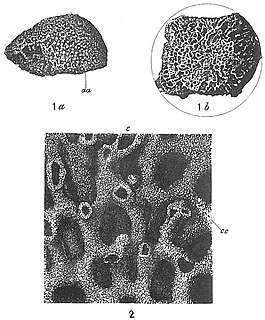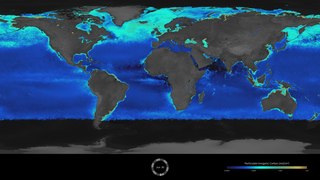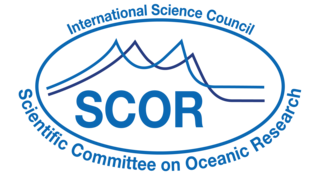
The biological pump, also known as the marine carbon pump, is, in its simplest form, the ocean's biologically driven sequestration of carbon from the atmosphere and land runoff to the ocean interior and seafloor sediments. It is the part of the oceanic carbon cycle responsible for the cycling of organic matter formed mainly by phytoplankton during photosynthesis (soft-tissue pump), as well as the cycling of calcium carbonate (CaCO3) formed into shells by certain organisms such as plankton and mollusks (carbonate pump).
The mesopelagiczone, also known as the middle pelagic or twilight zone, is the part of the pelagic zone that lies between the photic epipelagic and the aphotic bathypelagic zones. It is defined by light, and begins at the depth where only 1% of incident light reaches and ends where there is no light; the depths of this zone are between approximately 200 to 1,000 meters below the ocean surface.

In oceanic biogeochemistry, the solubility pump is a physico-chemical process that transports carbon as dissolved inorganic carbon (DIC) from the ocean's surface to its interior.

In oceanic biogeochemistry, the continental shelf pump is proposed to operate in the shallow waters of the continental shelves, acting as a mechanism to transport carbon from surface waters to the interior of the adjacent deep ocean.

Iron fertilization is the intentional introduction of iron to iron-poor areas of the ocean surface to stimulate phytoplankton production. This is intended to enhance biological productivity and/or accelerate carbon dioxide sequestration from the atmosphere. Iron is a trace element necessary for photosynthesis in plants. It is highly insoluble in sea water and in a variety of locations is the limiting nutrient for phytoplankton growth. Large algal blooms can be created by supplying iron to iron-deficient ocean waters. These blooms can nourish other organisms.

The Bermuda Atlantic Time-series Study (BATS) is a long-term oceanographic study by the Bermuda Institute of Ocean Sciences (BIOS). Based on regular research cruises, it samples an area of the western Atlantic Ocean nominally at the coordinates 31°40′N64°10′W. The cruise programme routinely samples physical properties such as ocean temperature and salinity, but focuses on variables of biological or biogeochemical interest including: nutrients, dissolved inorganic carbon, oxygen, HPLC of pigments, primary production and sediment trap flux. The BATS cruises began in 1988 but are supplemented by biweekly Hydrostation "S" cruises to a neighbouring location that began in 1954. The data collected by these cruises are available online.

Syringammina is a xenophyophore found off the coast of Scotland, near Rockall. It is one of the largest single-celled organisms known, at up to 20 centimetres (8 in) across. It was first described in 1882 by the oceanographer John Murray, after being discovered on an expedition in the ship Triton which dredged the deep ocean bed off the west coast of Scotland in an effort to find organisms new to science. It was the first xenophyophore to be described and at first its relationship with other organisms was a mystery, but it is now considered to be a member of the Foraminifera.
The benthic boundary layer (BBL) is the layer of water directly above the sediment at the bottom of a body of water. It is generated by the friction of the water moving over the surface of the substrate. The thickness of this zone is determined by many factors, including the Coriolis force.
Karen Frances Wishner is an American oceanographer currently at University of Rhode Island and an elected fellow of the American Association for the Advancement of Science. Her interests include coastal shelf and zooplankton behavior and environment, and has published her findings.
The Geochemical Ocean Sections Study (GEOSECS) was a global survey of the three-dimensional distributions of chemical, isotopic, and radiochemical tracers in the ocean. A key objective was to investigate the deep thermohaline circulation of the ocean, using chemical tracers, including radiotracers, to establish the pathways taken by this.

The lipid pump sequesters carbon from the ocean's surface to deeper waters via lipids associated with overwintering vertically migratory zooplankton. Lipids are a class of hydrocarbon rich, nitrogen and phosphorus deficient compounds essential for cellular structures. This lipid carbon enters the deep ocean as carbon dioxide produced by respiration of lipid reserves and as organic matter from the mortality of zooplankton.
Sharon Louise Smith is an American marine ecologist known for her work on zooplankton and their ability to respond to climate change. Smith was Professor Emeritus at the Rosenstiel School of Marine and Atmospheric Science at the University of Miami.
Cindy Lee is a retired Distinguished Professor known for her research characterizing the compounds that comprise marine organic matter.

Particulate inorganic carbon (PIC) can be contrasted with dissolved inorganic carbon (DIC), the other form of inorganic carbon found in the ocean. These distinctions are important in chemical oceanography. Particulate inorganic carbon is sometimes called suspended inorganic carbon. In operational terms, it is defined as the inorganic carbon in particulate form that is too large to pass through the filter used to separate dissolved inorganic carbon.

The Great Calcite Belt (GCB) of the Southern Ocean is a region of elevated summertime upper ocean calcite concentration derived from coccolithophores, despite the region being known for its diatom predominance. The overlap of two major phytoplankton groups, coccolithophores and diatoms, in the dynamic frontal systems characteristic of this region provides an ideal setting to study environmental influences on the distribution of different species within these taxonomic groups.

The Scientific Committee on Oceanic Research (SCOR) is an interdisciplinary body of the International Science Council. SCOR was established in 1957, coincident with the International Geophysical Year of 1957-1958. It sought to bring scientists together to answer key ocean science questions and improve opportunities for marginalised scientists.

The Martin curve is a power law used by oceanographers to describe the export to the ocean floor of particulate organic carbon (POC). The curve is controlled with two parameters: the reference depth in the water column, and a remineralisation parameter which is a measure of the rate at which the vertical flux of POC attenuates. It is named after the American oceanographer John Martin.
Zanna Chase is an ocean-going professor of chemical oceanography and paleoceanography at the Institute of Marine and Antarctic Science, University of Tasmania, Australia. She has undertaken over 20 voyages on research vessels, and her areas of expertise are Antartic paleoclimate, marine carbon cycle, radionuclides in the ocean, sediment geochemistry, paleoceanography, and marine biogeochemistry. In 2013 she was awarded with an ARC Future Fellowship.
Low-nutrient, low-chlorophyll (LNLC)regions are aquatic zones that are low in nutrients and consequently have low rate of primary production, as indicated by low chlorophyll concentrations. These regions can be described as oligotrophic, and about 75% of the world's oceans encompass LNLC regions. A majority of LNLC regions are associated with subtropical gyres but are also present in areas of the Mediterranean Sea, and some inland lakes. Physical processes limit nutrient availability in LNLC regions, which favors nutrient recycling in the photic zone and selects for smaller phytoplankton species. LNLC regions are generally not found near coasts, owing to the fact that coastal areas receive more nutrients from terrestrial sources and upwelling. In marine systems, seasonal and decadal variability of primary productivity in LNLC regions is driven in part by large-scale climatic regimes leading to important effects on the global carbon cycle and the oceanic carbon cycle.
Maureen Hatcher Conte is biogeochemist known for her work using particles to define the long-term cycling of chemical compounds in seawater.











